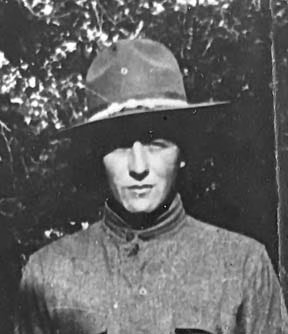In a way, Clarence McCormack’s life was like any other young man on the North Dakota prairie. He worked on the farm as a mechanic three miles south of Donnybrook, the youngest of 10 children, and hoped to get married and have a farm of his own one day.
But a decision in Congress on April 6, 1917, threw a monkey wrench into McCormack’s life and the lives of 4.8 million other Americans who fought in a war “over there.”
That decision was a declaration of war on Germany that sent most of these Americans to France where they ended up in the “War to End All Wars,” which later became known as World War I.
Young men were getting drafted to support the American cause but McCormack enlisted. In fact, he was the first person from Ward County to volunteer to fight in France and he was the first Ward County Soldier to die in the war. He was 22 years old when he died. His brother Irvin also enlisted and his sister Mary joined the Army Nurses Corps.


McCormack enlisted in Minot and wound up with Company K, 16th Infantry Regiment, 1st Infantry Division, eventually taking a fighting position in France, 55 miles northeast of Paris.
McCormack and four other Soldiers were in a trench July 20, 1918 during the Battle of Soissons when a German shell exploded nearly on top of them, killing four of the five including McCormack. The one man who survived, later recalled what had happened.
A 1919 article in the Donnybrook Courier explains the obvious, according to the surviving Soldier.
“On July 20, about 8 o’clock, while we were still assaulting the retreating Prussian guard and German line, a high explosive shell struck among the five of us, and three others unknown to me. I was blown into the air, the bomb striking very close, a foot or so from me, and I was badly wounded in the shoulder and arm and left leg. When I came to, I saw Clarence McCormack, and the three others lying close to me dead. So far as I could see, Clarence was badly wounded and mutilated.”
That explosion would immediately resonate in France and in the United States through a newsreel. This silent form of communication was used often in movie houses to show American progress in the wars and propaganda about the war.
Members of the U.S. Army Signal Corps filmed the near impossible Battle of Soissons. The footage was taken under combat conditions and used as an official film to document American actions during World War I. Its last known viewing was in a CBS documentary in 1960.
The newsreel from the Battle of Soissons revealed something nobody in Donnybrook, or North Dakota for that matter, wanted to see.
According to Donna Davis, who has knowledge of the McCormack family, wrote a note that appeared on the family tree website Ancestry.com. She stated, “Clarence’s mother Sidney was watching footage of the battle when the death of her son was unfolded in front of her eyes, even before receiving a letter from Washington, D.C., telling of his death.”


No. 1, just imagine the shock and grief of seeing that and No. 2, it’s amazing that a newsreel could survive being that close to a blast that killed four of five Soldiers.
As a result of witnessing the explosion and that another son Irvin returned from the war shell shocked, Sidney wore black dresses for the rest of her life. Following the war, the McCormack family sold their Donnybrook farm and moved to Sand Point, Idaho.
The news of McCormack’s death was graphic enough, but to this day, his body has not been recovered and buried.
According to the organization American War Memorials, McCormack was officially declared killed in action on July 20, 1918, but also declared missing on the third day of the five-day battle of Soissons.
He and 1,060 other American Soldiers who were never recovered from World War I, are memorialized on Tablets of the Missing at the Aisne-Marne American Cemetery in Belleau, France.
The tablets are located inside the memorial chapel bearing the names of all the Americans.
On Aug. 1, 1919, McCormack was posthumously awarded the World War I Victory Medal with a Silver Citation for gallantry in action, an award that was replaced by the Silver Star in 1932.
About the same time, McCormack posthumously received a tribute from French President, Raymond Poincare.
On Oct. 1, 1920, the American Legion granted a charter post in Donnybrook that became known as the Clarence McCormack American Legion Post 195.
A myriad of posts were chartered in the early ‘20s most often named after deceased young Soldiers to honor and commemorate their service and sacrifice, especially those from the local community.
And in Donnybrook’s case, it was named after Pfc. Clarence McCormack, who today remains a local hero in Donnybrook, in Ward County, in North Dakota and in the U.S. Army.
Today, the Clarence McCormack post and auxiliary remain active with Memorial Day and Veterans Day programs and burial honors.
“Mort pour la France!”
Fighting in the War to End All Wars
The Battle of Soissons of 1918 was fought on the Western Front between the French with American and British assistance against the German armies. It was part of the much larger Allied offensive called the Aisne-Marne counter-offensive.
The primary objective of the battle was to cut off a road and railroad that were major supply routes for the Germans in the Marne salient. By attacking the routes, the Allies severely im-paired the Germans’ ability to supply its armies in that part of France.
The Germans were later forced to retreat and the Battle of Soissons marked the turning point of the war as the Germans would be on the defensive for the remainder of the War that raged nearly four months after the battle.
During the much larger Aisne-Marne couter-offensive, the Allies achieved a major breakthrough, pushing the Germans back across the Marne River. The Allies captured 134,000 prisoners and 187 guns during the offensive’s initial phase.
The Aisne-Marne marked the first major successful Allied counter-offensive in the war, swinging the momentum in favor of the Allies.
It boosted morale throughout the Allied forces, especially in France, following a string of German successes.
Two months after the success of the Aisne-Marne, the 16th Infantry was involved in another major battle of World War I, the Meuse-Argonne offensive which was fought from Sept. 26 to Nov. 11, 1918, when an armistice was signed ending the war.
Read the full “Tribute to Service” feature at https://northernsentry.com/3d-flip-book/tribute-to-service-2025/













